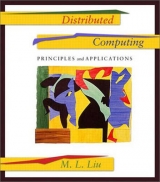
Distributed Computing
Pearson (Verlag)
978-0-201-79644-5 (ISBN)
- Titel erscheint in neuer Auflage
- Artikel merken
Distributed Computing provides an introduction to the core concepts and principles of distributed programming techniques. It takes a “how-to” approach where students learn by doing. Designed for students familiar with Java, the book covers programming paradigms, protocols, and application program interfaces (API's), including RMI, COBRA, IDL, WWW, and SOAP. Each chapter introduces a paradigm and/or protocol, and then presents the use of a DPI that illustrates the concept. The presentation uses narrative, code examples, and diagrams designed to explain the topics in a manner that is clear and concise. End-of-chapter exercises provide analytical as well as hands-on exercises to prompt the reader to practice the concepts and the use of API's covered throughout the text. Using this text, students will understand and be able to execute, basic distributed programming techniques used to create network services and network applications, including Internet applications.
1. Introduction.
What is distributed computing?
Basic network concepts.
Basic operating system concepts.
Basic software engineering concepts.
The Internet.
Network resources and their identification: computers, services, resources, host names, host identifiers, port addresses, the domain name system, Internet addresses, Uniform Resource Locator (URL), Uniform Resource Identifier (URI).
Security.
Fault Tolerance.
2. Interprocess Communication.
Basic model .
Primitives (operations): connect, send, receive, disconnect.
Connection-oriented/connectionless.
Data marshalling: data flattening, data representation, serialization.
Event synchronization.
Event diagram, sequence diagram.
3. Distributed Computing Paradigms.
Array of paradigms that have evolved for distributed computing.
A historical look at the evolution of these paradigms.
Overview & comparison of each paradigm.
4. The Socket API.
The basic model.
Stream-mode (connection-oriented) socket.
Datagram socket (connectionless) socket.
Java socket API.
Using socket to implement a client.
Using socket to implement a server.
A simple middleware using sockets.
Secure sockets and the Java secure socket extension API.
5. The Client-server Paradigm.
The daytime protocol and a sample client-server suite.
The echo protocol and a sample client-server suite.
Connection-oriented client-server.
Connectionless client-server.
Iterative server and concurrent server.
Stateful server and stateless server.
6. Group Communications.
Unicast versus multicast.
Basic model of group communications.
The Java multicast API.
Sample multicast sender program.
Sample multicast listener program.
Multicast and message ordering.
Reliable multicast/broadcast.
7. Distributed objects.
Message passing versus distributed objects.
The basic model.
Remote procedure call.
Remote method invocation.
8. Advanced Remote Method Invocations (RMI).
RMI stub downloading.
security policy.
Callback.
9. Internet applications.
Basic components and protocols: HTTP, HTML, MIME, web server, browser, web forms.
Web document types: static, dynamic, executable, active.
CGI: background; interaction and passing of data among browser, web server, and script(s).
HTTP Session state information: hidden tags, cookies, session objects.
Client-side programming: Applets, JavaScript.
Server-side programming: common gateway Interface (CGI), servlets, server pages.
10. The Common Object Request Broker Architecture (CORBA).
Basic architecture.
Object Servers and Object Clients.
Object References.
Naming services.
Object services.
Object adapters.
Java IDL.
11. Internet Applications - continued.
Applets.
Servlets; session data maintenance.
Web services and the Simple Object Access Protocol (SOAP).
12. Advanced Distributed Computing Paradigms.
Message queue system.
Mobile agents.
Network services.
Object spaces.
| Erscheint lt. Verlag | 30.6.2003 |
|---|---|
| Sprache | englisch |
| Maße | 200 x 230 mm |
| Gewicht | 807 g |
| Themenwelt | Mathematik / Informatik ► Informatik |
| ISBN-10 | 0-201-79644-9 / 0201796449 |
| ISBN-13 | 978-0-201-79644-5 / 9780201796445 |
| Zustand | Neuware |
| Haben Sie eine Frage zum Produkt? |
aus dem Bereich



